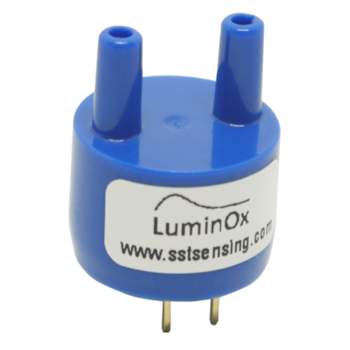Key features
- Sealed back end for easier gas sample management
- Virtually no cross-sensitivity to other gases
- RoHS & REACH compliant
- Works in vacuum and high oxygen concentrations
- Works directly with a microcontroller including Arduino and Raspberry Pi
- Provides partial pressure O2, percent O2, temperature and barometric pressure outputs
- T90 <30s (typical)
- Non depleting luminescence technology developed in-house
- Short lead times for samples
- Software available for testing purposes
- Specialist design engineers available to discuss design, testing and validation
Board sold separately
Overview
The LuminOx Sealed Optical Oxygen Sensor Range Offers Users With Application Requirements To Only Measure Sample Gas At The Front Face Of The Sensor.
The LuminOx Sealed Optical Oxygen Sensor is developed and manufactured by PST, it is part of the LuminOx family, which is a range of factory calibrated oxygen sensors which measure ambient oxygen levels using the principle of luminescence quenching.
The sensors each have an internal sensor for temperature and barometric pressure compensation, meaning the customer does not need to consider this in their design. It also communicates directly to the customers USART so no signal conditioning circuitry is required.
The LuminOx Sealed Optical Oxygen Sensor (LOX-02-S) is an extension to the standard range of LuminOx oxygen sensors. It is a similar diffusion type sensor like the original LOX-02 sensor. However, the LOX-02-S has a sealed base that is gas-tight, meaning only the face of the sensor with the protective membrane needs to be in the sample gas environment, externally leaving easy access to the pins of the sensor.The patented technology allows SST to produce a range of sensors that provides low power operation, while offering a much longer lifetime than electrochemical and galvanic sensors.
LuminOx is a completely solid state sensor and contains no lead or liquid electrolytes. It is therefore 100% RoHS compliant. It also has virtually no cross sensitivity, allowing it to be used in applications where other technologies are unreliable due to the particular mix of gases present.
The luminescence quenching principle measures the partial pressure of oxygen (ppO2). The internal barometric pressure sensor measurement along with the ppO2 measurement allows an oxygen concentration (O2%) value to be calculated. The USART output allows the sensor to communicate the values of O2%, ppO2, barometric pressure, internal temperature and a sensor status.







